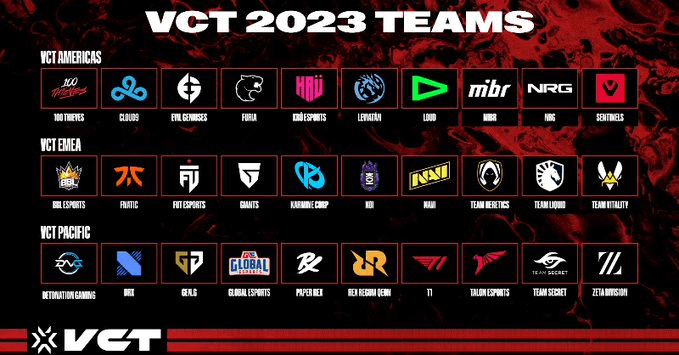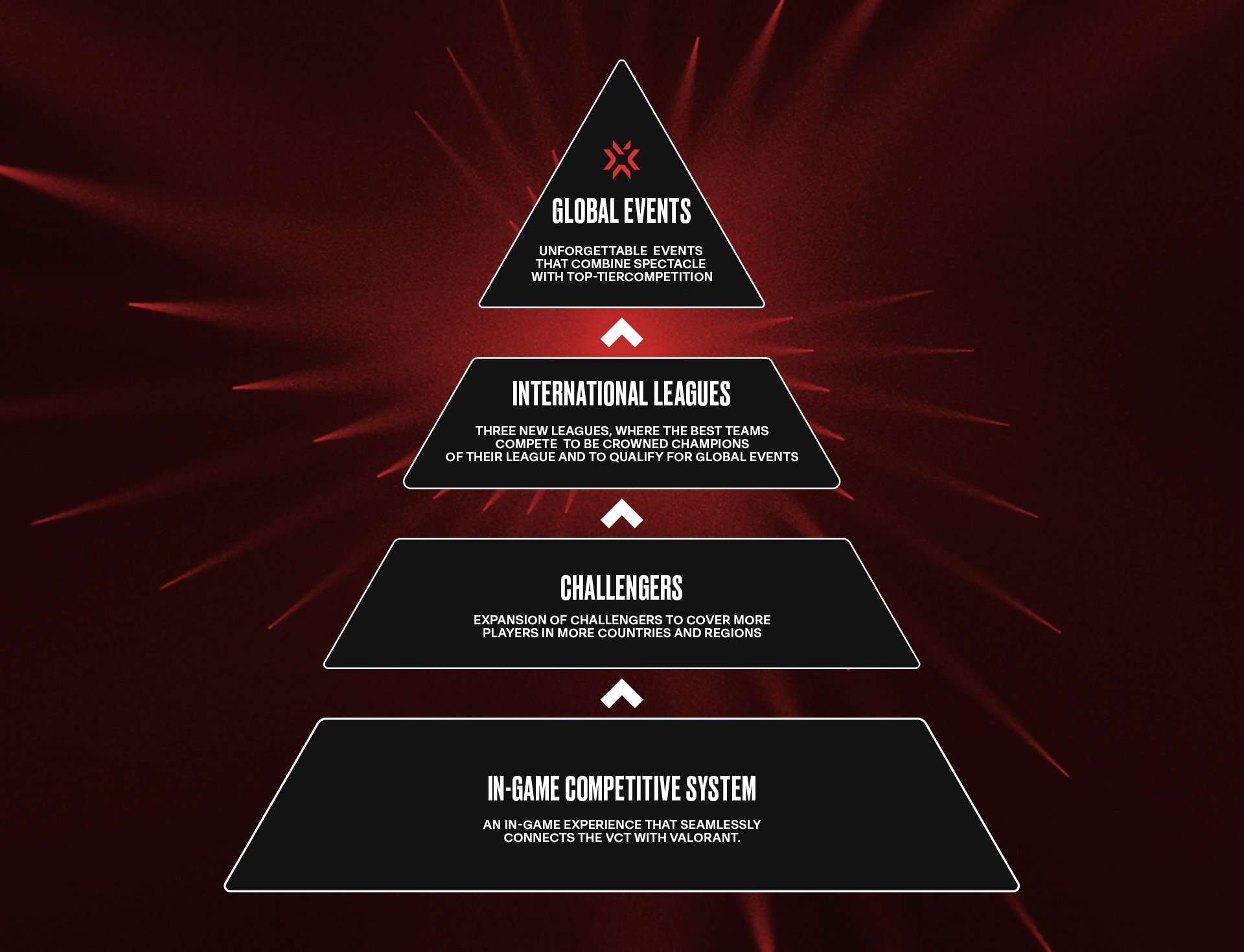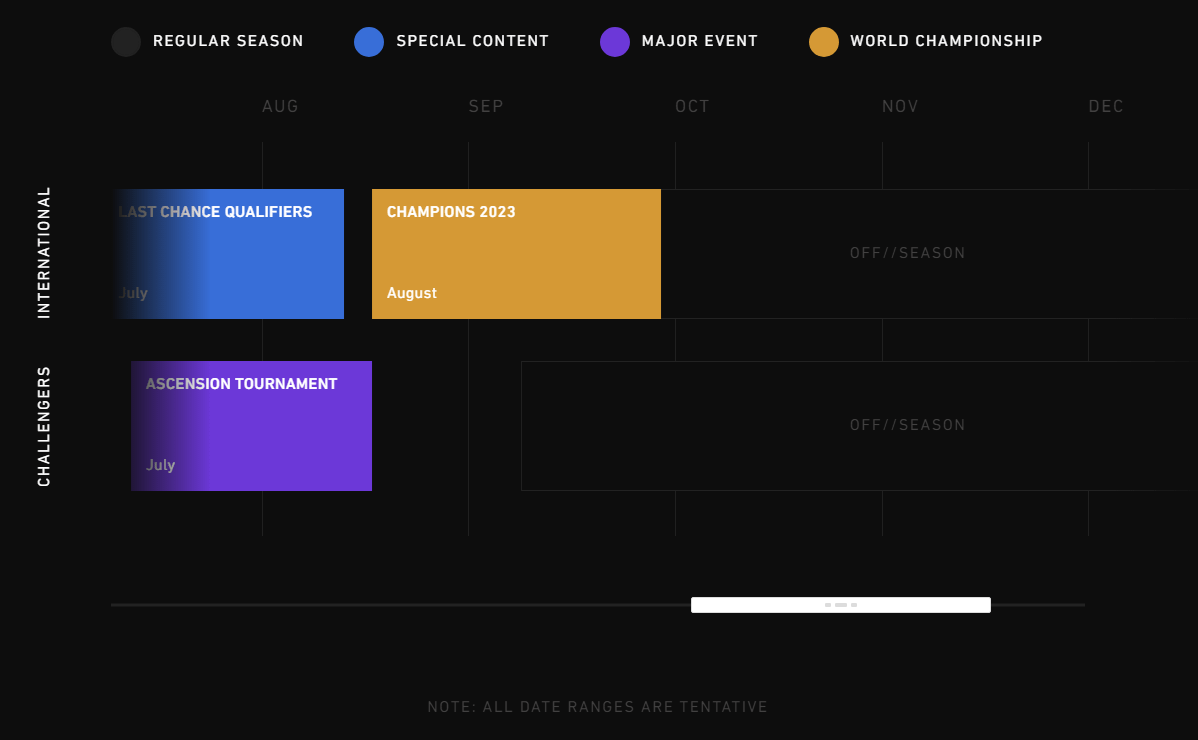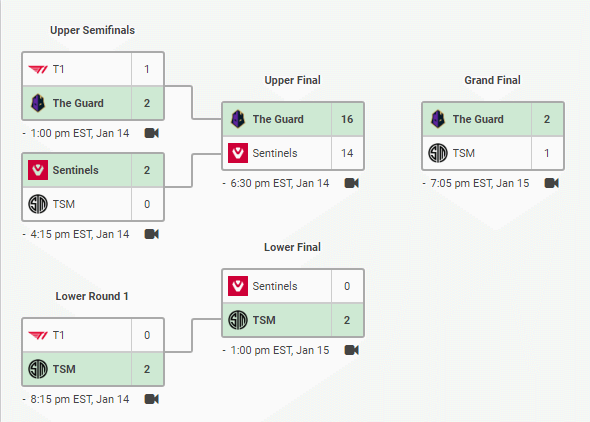VALORANT Franchising: The Good, the Bad, and the Ugly
Now that the first regular season of the Valorant franchising league has completed, this article aims to discuss the state of the league, good or bad. This article is purely opinion and serves to highlight the highs and lows of the current structure of the VCT leagues as well as the various Challenger leagues that feed into the promotion system.
Before getting into the discussion, let’s have a quick review of the current structure of the league. As of now, the league is subdivided into 3 regions, Americas, EMEA, and Pacific. Each of these regions have 10 teams and respective tier 2 leagues known as Challenger or Ascension Leagues.
The 30 teams in the main leagues receive subsidies from Riot, play in regular season games, and can qualify for international tournaments and the world championships.
The tier 2 Challenger/Ascension leagues serve as an avenue for teams outside of the main Franchised league to enter the main league for a set duration, receive all the same benefits and opportunities as the main Franchised teams, and then will be relegated out of the league. From there they will have to be promoted once again via the Ascension system.
For more pro analysis, explore more of our blog content. To improve your game, head to our all-in-one VALORANT site.

The Good
First let’s get into the things that are working well in the league. To me the primary positive aspect of the league is the competition and structure it gives to the competitive scene of the game. This is done through the league itself as well as giving incentive for teams outside of the league.
Competitive Structure
The league inherently gives structure to competition. The format of the main Franchised league gives a consistent schedule to the game. The existence of a regular season and playoffs makes the competitive scene much clearer and far easier to understand due to its parallels with traditional sports. League play also gives an overall greater volume of higher-end competition.
In the old system there were so few tournaments that the game had intermittent breaks that were rather long without play. The regular season guarantees at least 9 games to every team. This lets the viewers see more of their favorite team and root for them in a clearer path to the biggest tournaments on the world stage.
The structure also gives a roadmap from the regular season, to regional playoffs, to international events and Champions. This gives weight to events while increasing the overall volume of play, a dichotomy that is very hard to balance. Too few games and each game becomes extremely meaningful, but viewers see fewer games and a teams’ seasons can be over in a blink of an eye.
Too many games and the best teams are most likely getting into playoffs and international events, but games begin to feel meaningless, and overall interest declines. This is akin to the MLB which has 162 games in a season, where many teams play dozens of meaningless games as they are eliminated from playoffs, have a sizable lead, or their position won’t change.

Joining the League
Tier 2 doesn’t have the structure that the Franchised league has, but its existence is a huge plus. This gives teams the opportunity for a great financial opportunity in being promoted into the league that is earned, not paid for.
This is a great avenue for teams not in the league to play for, and is a great addition to have at the very start of the league as it not only gives a path for new teams to join the league, but a means of expanding the league. This will be discussed later on because this aspect of the system is great to have, but definitely needs to be improved on to keep up motivations for teams in the long run.
Parity
For the first year of the league I was pleasantly surprised by the parity. The writing of this took place during Masters Tokyo, an event that has its clear favorites, but an event that has at least 7 teams that have a legitimate chance of winning the event.
Even during the regular season there was solid competition in each of the regions. Only 2 teams of the 30 had 1 win or fewer. The standard deviation of wins in the Americas and EMEA league was 2.36 wins and 2.27 wins in the Pacific league.
The smaller this number is the more parity there is in the league, as more teams will be closer to the center of the league in record. There were a lot of teams vying for the final spots in the playoffs, especially in the Americas where half of the teams were at 4-5 and in a tie-breaker for the final last three spots of playoffs.
This last point does highlight that there may be too few games in a season, as all of the tiebreakers need to be broken out to separate half the league. This is what leads us into the bad.

The Bad
Having structure and a schedule is great, but the problem of overall lack of volume of play still persists. Albeit this problem isn’t as bad as it was, the issue is still there. This is mostly apparent in the tier 2 scene where some teams have a painfully long break.
A Long Winter
In the North American challenger league there are multiple signed teams whose season is completely over as of June. It is very hard for players and organizations to remain invested in the scene during a half year or greater hiatus before the next meaningful play resumes.
There is a very high chance there may be some type of exodus of the tier 2 scene if there is no investment in Riot during this long break until the next season of Ascension begins.
This is very similar to LCS in League of Legends in which the tier 2 scene has dwindled and there is little justification for organizations to spend money in the area, which overall dissuades players and new talent from playing in the lower levels. These speed bumps for new talent overall hurt the tier 1 teams as there are fewer new, high-end players incoming.
Riot has mentioned wanting to create hunger for fans for the return of Valorant after an offseason. This is an instance in which they are trying to create a system too similar to traditional sports. Teams in pro sports league and the Franchise league are fine with waiting as their spot and money are guaranteed next year. For teams in tier 2 this is definitely not the case.
A linebacker on the Denver Broncos who has a 3 year contract secured is more than okay with waiting for the half year or longer until next season; a controller player on the Ascension-hopeful Kitten Shelter is justifiably not. Organizations and players who invest in tier 2 are investing at a chance of Ascension with a high risk of failing and having to wait another year.
These organizations and players do not have time to wait for the hunger of fans to set in. They need constant viewership and prize pools to help hedge the risk that inherently exists with the Ascension format. If Riot doesn’t introduce something for these teams and players, new talent and cash-carrying orgs won’t find this system worth their time which will hurt the league at all levels over time.
The Premier system has the potential to fill in these gaps and offer more forms of open qualification that only exists very early on in the Ascension format. The system will need to be built up such that it allows for spectating and open qualifications for prize pool events.

More Games, Less Tie-Breakers
The current system was a good start for having a regular season. But in future seasons, playing each team once is simply not enough to separate the teams at the middle of the pack. Playing each team twice will better differentiate the teams in the middle of the league, and make the final playoff spots more based on earning it through matches rather than relying on the 3rd tie-breaker in the format.
This will do a few things. Give more games for fans to enjoy, make the offseason shorter, and ensure teams perform consistently to earn a playoff spot. This must be balanced against the league growing in size and other factors to avoid there being too many regular season games to avoid the aforementioned MLB dilemma of having many games that serve no purpose.
The Ugly
This section is always the hardest to come up with, but in the case of Valorant Franchising there are some weird aspects that are confusing, weird, and need to be talked about.
Rules and Rosters
When the league was introduced roster construction restrictions were given as well. There is meant to be 1 coach and at least 6 players (up to 10) in case a substitute is needed for a player unable to play. Some teams use assistant coaches as their sixth, some teams went spurts with only having 5 “players” because they dropped their assistant coach or a player in the middle of the split, and meanwhile EG has 10 players.
Not only the rules aren’t 100% clear with who constitutes as a player for a team, but there is also a lack of clarity on using substitutes in the middle of matches. There are mixed reports on when teams declare if they are using a substitute and submitting their roster for a match. A potential use of a substitute should be using certain players on certain maps, so there should be standard practice of allowing subs to come in once the map pool is decided.
Rules on the roster are unclear, just like other rules such as bugs, exploits, and replaying rounds. There still isn’t any fundamental clarity on certain issues such as when using an exploit like a Cypher camera that sees through spawn barriers is illegal and its associated penalty or a Killjoy Turret shooting at nothing is worth replaying a round. This really needs to be developed sooner rather than later, because in its current state the rules are rather laissez faire.
Talent Left Out
One of the pillars of having a tier 1 league is that the top talent congregates there. The pinnacle of play should have the best of the best there. Yet the best player of 2022 is not on a team, there seems to be a plethora of players in Ascension leagues that are upgrades to Franchise teams, and in NA Ascension alone there are 3 teams that can beat many Franchise teams across the 3 regions.
This is something that’ll most likely settle itself over time, but at the moment it’s very odd. With players’ levels of play in esports being volatile and short on plenty of occasions due to balance changes, the nature of the game, etc., having a “roster lock” before the season gets underway doesn’t have much value. This more restricted teams and left players out based on circumstances they had little control over.

Moving Forward
As a fan of the competitive scene of the game, all in all the first year has definitely been a good start. The competition has been great, and Masters Tokyo thus far has emphasized that as the games have been fantastic and tournament favorites have been challenged and/or knocked out due to the depth of the field. The level of play has improved over the past year immensely and will only get better over time as new Ascension teams come in and the high-end players who were left out of franchising eventually find their ways in.
There is still plenty of room for improvement though. There are a few things out of Riot’s control, but there are quite a few things they can do to tidy up the rules and formatting to prevent future issues from rearing their heads. The most pressing one is the length of the off season and lack of incentive for organizations to stay committed to the game.
LCS shows what can happen if tier 2 isn’t properly supported, and Riot hosting or assisting with 3rd party tournaments during the off season that helps support these teams through prize pools and visibility. The Ludwig x Tarik Invitational was a great example of an event that combines franchised teams and Ascension teams.
This can be built upon to include more teams with open qualifiers for non-franchised teams and invitations to top Ascension and Franchised teams to attract more players to participate without needing to expand the prize pool.
The less pressing issue that is an easier fix is the rules. Fortunately this year there has yet to be any egregious rulings or lose-lose scenarios for tournament organizers such as the Killjoy Turret bug or invincible Cypher cams, but tightening up the rules for roster construction, exploits, bugs, and round replays will help avoid any future scenarios where Riot is stuck between a rock and a hard place on making a decision.
The last bit I would lump into this category is the audio. This is definitely a harder solution to come to, but now that all games are on LAN, Riot needs to find a better solution to masking crowd noise than the white noise earbuds under players’ headphones.
A viewer who is not familiar with the players’ audio situation can understandably be very confused when an enemy player runs close by and is unheard, or a Harbor Cove behind a High Tide isn’t shot out because players are unable to hear audio cues. This has been an issue for quite some time and it would be good to see it fixed with one of the aims of the league is to bring out the absolute highest level of play.
Conclusion
If you play Valorant and have yet to watch any of the games, check it out. They are definitely worthwhile, especially the international events. The level of gameplay is as high as it’s ever been and you will definitely be entertained and learn something new about the game from watching.
The next few months will have some pivotal points for the future of the league, and hopefully Riot recognizes the opportunities for improvement and takes advantage to better the league and squash potential future issues.
For more pro analysis, explore more of our blog content. To improve your game, head to our all-in-one VALORANT site.
 Download APP
Download APP Collapse
Collapse


